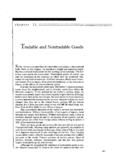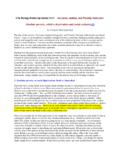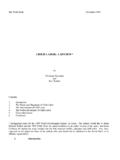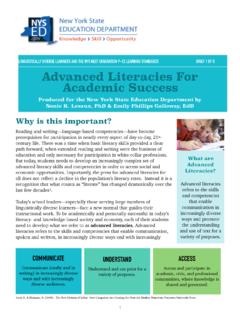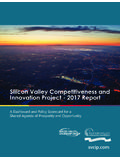Transcription of The Power to Choose - gdsnet.org
1 The Power to Choose Bangladeshi Won1cn and Labour Market Decisions in London and Dhaka NAILA KABEER VERSO London new york Preface and acknowledgements The idea for this book came about in response to an apparent paradox relating to the work patterns of two groups of Bangladeshi women workers living several thousand miles apart. The first group came to my attention when I visited Bangladesh in 1984 after an absence of three years. I was struck then by the sight of thousands of young women moving briskly around on the streets of Dhaka. In a city, and a country, where women had been conspicuous by their absence in the public domain, this was not merely a new phenom-enon, but a remarkable one.
2 I was told that they worked in the new garment factories which had sprung into existence almost over-night in response to incentives put in place by the government in 1982 to promote export-oriented manufacturing. Very soon after this, as a result of my involvement in a campaign which I describe in Chapter 1 of the book, I heard about another group of Bangladeshi women also working in the clothing industry, but this time in the East End of London. However, they had been incorporated into a very different form of employment in the industry. While much of the clothing industry in the UK is domi-nated by female labour, Bangladeshi women were largely absent from its factories and small, outdoor units.
3 They worked instead as home-based machinists, paid on a piecework basis. At a time when research based on official statistics in the UK had declared that manufacturing homework was a 'relative rarity', an anachronism from the last century, these women represented a rising trend in the British garment industry of subcontracting out the machining stages of production to home-based outworkers. It was not the fact that Bangladeshi women took up different forms of paid work in the garment industries in these two contexts VIII PREFACE AND ACKNOWLEDGEMENTS that was puzzling-they were, after all, located in different labour market~ in different part~ of the world -but rather the counter-inlllitive forms that their work had taken in the two context~.
4 Ln Bangladesh, a country where strong norms of purdah, or female seclusion, had always confined women to the precinct<; of the home and where female participation in public forms of employment had historically been low, the apparent ease with which women appeared to have abandoned old norms in response to new oppor-tunities went against the grain of what has been presented in the development literature as one of the least negotiable patriarchies in the world. By contrast, in Britain, a secular country accustomed to the presence of women in the public arena, and with a tradition of female factory employment going back over a hundred years, particularly in the clothing industry, Bangladeshi women were largely found working from home, in apparent conformity with purdah norms.
5 A reading of the literature on the international division oflabour in the garment industry suggested that this paradoxical set of labour market outcomes could be explained at a number of different levels. There was an explanation at the global level which stressed the extensive geographical restructuring of textile and garment manufacturing since the late 1960s and the very different patterns of employment it gave rise to in different parts of the world. There was an explanation at the national level, which explored the local organisation of the garment industry in different countries and the demand for different categories of labour which this generated. And finally, there was a third, micro-level set of explanations which relates to the lives and circumstances of individ-ual workers and their motivations for taking up particular forms of employment in different contexts.
6 It is this third level of analysis which forms the main substance of this book. The book can be seen as drawing on two different kinds of explanatory narratives which have a bearing directly, or indirectly, on the labour market outcomes outlined above. The f1rst set of narratives are those related in the third person: in other words, they are narratives about the women workers in question. Some of these are populist in origin, the accounts of journalists, trade unionists, feminist activists and employers, a range of people ENTS PREFACE AND ACKNOWLED(,EM ix form of f irst-or second-hand who bad, or claimed to ha~eh S(~~1~e-e more academic and take the knowledge of the workers. btl e ~ ai -of S(>CI I actors in general, of.)))
7 B t the e 1aVIOUI u form of the(HJes a ou . ibed above represent particular whom the women workers desCI d f -men's labour . f \es put forwar 01 wo examples. The vano\Is ~a IOna_ .. rse narratives constitute one market behaviour w tlun these dive .. I third-. dox In addltlon to t 1ese kind of explanatton for oui -. a\ o first-person narratives, -h there ai e s person narratives, owever, here about themselves. Such those told b_"i women workers' eve ~ . ts of their behaviour, of . h rkers own accoun narratives contall1 t e wo k d ork and to opt for . I I d h to see pa w the motivations whic l e t em h ther Such narratives offer one form of employment rather t a~1 ano.)
8 Dox which may or an alternative set of explanations or our para may not converge with the first set. Objectives . her both sets of narratives in order I have attempted to bnng t?ge_t Th first objective is a straight-to achieve a m mber of obJecuves. eh -sons for the paradox-. 1 Itistofindoutt eiea forward empinca one.. d b Bangladeshi women in the . I I bour market chmces rna e y ' .. ICa a .. an ladesh The second obJective IS more contexts of Bnta1l1 and B g h 'fit' between the d seeks to compare t e theoretical in nature an .. d its implications, f h . I bour market behavwui' an accounts o t eJr a k . 1 the two contexts and . 1 d 11-omen wor ers 11 provided by Bang a es I w ' I bour market behaviour put the theoretical accounts of women s a forward in the social science literatu.
9 E: I objective for undertaking FinallY, I had a third and more po Itica_ la Jnethodology which ' c d f g the parucu this research and .or a op 111 . I have outlined above . Th ets of narrauves has guided It: -e two s.. els of the human actor, either embody, implicitly or exphotly, mod. -I' . the shape of , -. or more connete ). 111 . in a general absu act sense, .. xplicit or impliCit k s They also contam e Third World wo111en wor er . 1 t be and how they . I . h , w rkers' mterests tmg 1 claims about w 1at t ese o r tl e rapid expansion and b red in the context 0 1 might best e sef\ .. 1 tnde However, these . d dence of Jnternauona ' . growing Inter epen . d . d -eel nay be in conflict.
10 The views do not always converge, an In e . 11 Weak winners, powerful losers: the politics of protectionism In international trade Finally, t eturning to the concerns outlined in the first chaplet , the analysis in this book offers one set of answers as to why many of those in the northern labour movement, who supported quotas on the import of clothing from Bangladesh on the grounds of the exploitative conditions which prevailed within the industry, remained silent on the equally exploitative conditions which pre-vailed for many in the British clothing industry. Women workers in Bangladesh were seen to be a legitimate focus for concern because their poverty made them vulnerable to exploitation by ruthless employers.
